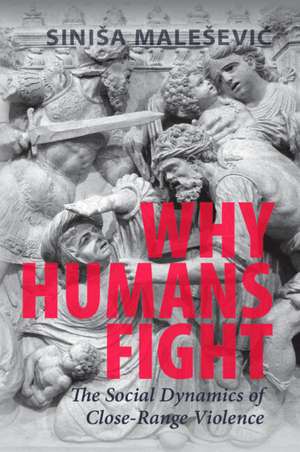Why Humans Fight: The Social Dynamics of Close-Range Violence
Autor Siniša Maleševićen Limba Engleză Paperback – 5 oct 2022
| Toate formatele și edițiile | Preț | Express |
|---|---|---|
| Paperback (1) | 208.79 lei 3-5 săpt. | +19.52 lei 6-10 zile |
| Cambridge University Press – 5 oct 2022 | 208.79 lei 3-5 săpt. | +19.52 lei 6-10 zile |
| Hardback (1) | 616.32 lei 6-8 săpt. | |
| Cambridge University Press – 5 oct 2022 | 616.32 lei 6-8 săpt. |
Preț: 208.79 lei
Nou
Puncte Express: 313
Preț estimativ în valută:
39.95€ • 43.53$ • 33.67£
39.95€ • 43.53$ • 33.67£
Carte disponibilă
Livrare economică 02-16 aprilie
Livrare express 18-22 martie pentru 29.51 lei
Preluare comenzi: 021 569.72.76
Specificații
ISBN-13: 9781009162814
ISBN-10: 1009162810
Pagini: 320
Dimensiuni: 152 x 228 x 20 mm
Greutate: 0.51 kg
Ediția:Nouă
Editura: Cambridge University Press
Colecția Cambridge University Press
Locul publicării:Cambridge, United Kingdom
ISBN-10: 1009162810
Pagini: 320
Dimensiuni: 152 x 228 x 20 mm
Greutate: 0.51 kg
Ediția:Nouă
Editura: Cambridge University Press
Colecția Cambridge University Press
Locul publicării:Cambridge, United Kingdom
Cuprins
Acknowledgements; Introduction: The social anatomy of fighting; 1. The body and the mind: Biology and the close-range violence; 2. Profiting from fighting: The economics of micro-level violence; 3. Clashing beliefs: The ideological fighters; 4. Enforcing fighting: Coercing humans into violence; 5. Fighting for others: The networks of micro-bonds; 6. Avoiding violence: The structural context of non-fighting; 7. Social pugnacity in the combat zone; 8. Organisational power and social cohesion on the battlefield; 9. Emotions and the close-range fighting; 10. Killing in war: The emotional dynamics of pugnacity; 11. The future of close-range violence; Conclusion.
Recenzii
'Sinisa Malesevic now commands the field dealing with nationalism, war and violence, gaining prize after prize as a result. This is his best book, full of new material, handled with enormous style, knowledge and subtlety. This book will last.' John Hall, McGill University
'Malesevic begins with a penetrating critique of genetic, biological, and psychological explanations for why humans fight, whether they be mere brawlers or trained soldiers. He then proceeds to a more sociological approach, while stressing the variability of fighting experiences. His arguments are supported by immense learning and a flow of acute insights into human violence. This is a must read for anyone interested in violence and war.' Michael Mann, University of California, Los Angeles
'Like Goya's war paintings, Why Human Fight surveys its horrible subject matter with an unblinking gaze. One of the many achievements of this extraordinary survey is to zoom in closely upon the often-overlooked micro-solidarities that enable social pugnacity to develop. Here Malesevic's own interrogation of diverse literatures is relentless; his curiosity boundless; and his insights often startlingly original. A dark, and exhilarating, survey: and, in the troubled 21st century, an urgently needed book.' Tim Wilson, University of St Andrews
'This exceptionally wide-ranging study lives up to its multidisciplinary ambitions by offering both in-depth research on particular instances of violence, and panoptic breadth in terms of its comprehension and digestion of an ever-widening research field. Malesevic manages to bring together and offset different strands of scholarship and formulate a clear new perspective that will offer food for thought for a good while.' Ugur Ungor, University of Amsterdam
'Sinisa Malešević has delivered a sweeping social history of face-to-face violence. In this masterful book, Malešević shows how violence is an inherently social, relational phenomenon, and he identifies the social structures that lay the foundation for organized killing. This book is ambitious, rigorous, and deeply convincing.' Erica Chenoweth, Harvard University
'Malesevic begins with a penetrating critique of genetic, biological, and psychological explanations for why humans fight, whether they be mere brawlers or trained soldiers. He then proceeds to a more sociological approach, while stressing the variability of fighting experiences. His arguments are supported by immense learning and a flow of acute insights into human violence. This is a must read for anyone interested in violence and war.' Michael Mann, University of California, Los Angeles
'Like Goya's war paintings, Why Human Fight surveys its horrible subject matter with an unblinking gaze. One of the many achievements of this extraordinary survey is to zoom in closely upon the often-overlooked micro-solidarities that enable social pugnacity to develop. Here Malesevic's own interrogation of diverse literatures is relentless; his curiosity boundless; and his insights often startlingly original. A dark, and exhilarating, survey: and, in the troubled 21st century, an urgently needed book.' Tim Wilson, University of St Andrews
'This exceptionally wide-ranging study lives up to its multidisciplinary ambitions by offering both in-depth research on particular instances of violence, and panoptic breadth in terms of its comprehension and digestion of an ever-widening research field. Malesevic manages to bring together and offset different strands of scholarship and formulate a clear new perspective that will offer food for thought for a good while.' Ugur Ungor, University of Amsterdam
'Sinisa Malešević has delivered a sweeping social history of face-to-face violence. In this masterful book, Malešević shows how violence is an inherently social, relational phenomenon, and he identifies the social structures that lay the foundation for organized killing. This book is ambitious, rigorous, and deeply convincing.' Erica Chenoweth, Harvard University
Notă biografică
Descriere
Malešević offers a novel sociological answer to the age-old question: 'Why do humans fight?', by emphasising the centrality of social contexts that make fighting possible.
